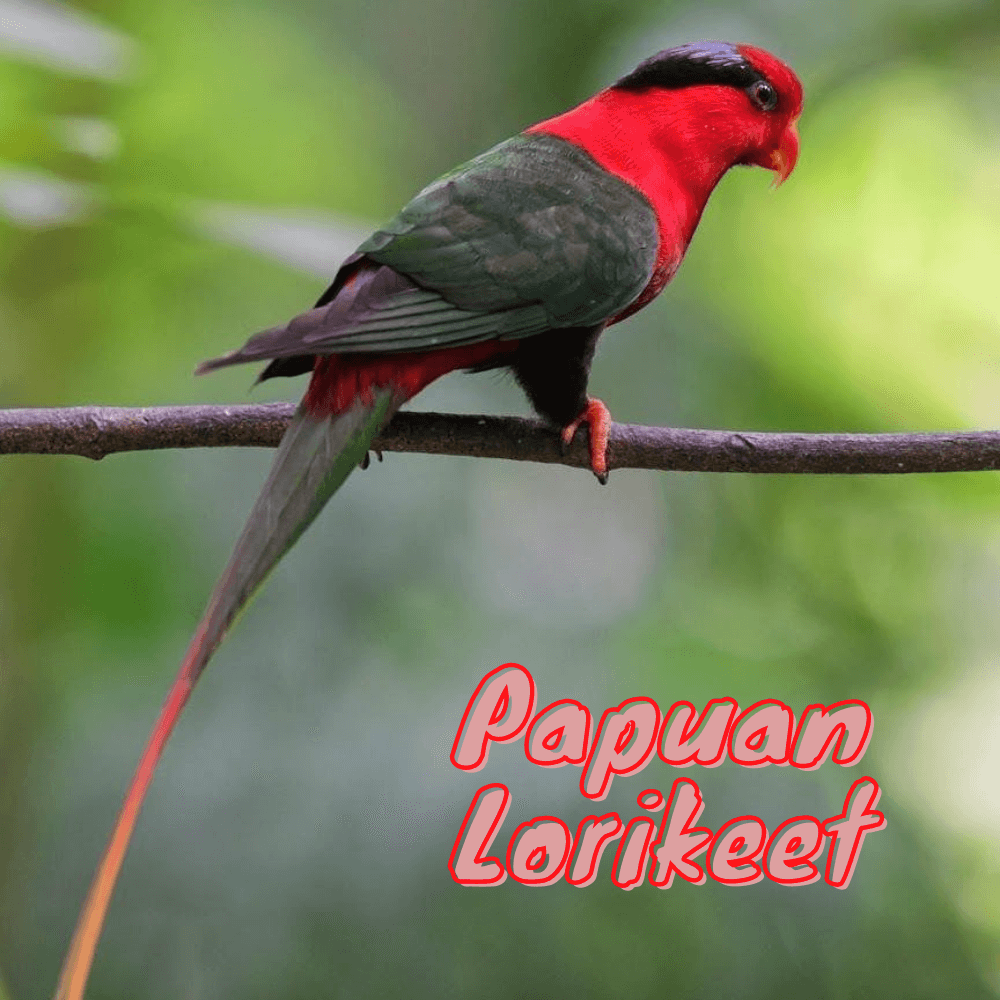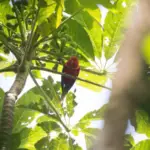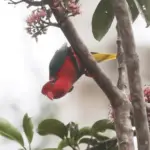
Papuan Lorikeet (Vogelkop) 36–42 cm; 74–113 g. Upper body and underparts red with a blue band across mid-crown bordered black on the hind crown, black line on hindneck, broad black band on belly and thighs, yellow patch on side of breast and flank behind thigh;
mantle, wings, and tail dark green, with primary tips somewhat elongate and very long (20–25 cm) central tail streamers, tipped yellow; underwing-coverts red, the underside of flight-feathers blackish; lower back and sides of rump red, central rump blue shading to green on upper tail-coverts; bill and legs orange.
Some have the upper wing light green, distinctly paler than the back, and some blue feathers on the alula, remiges, and upper wing coverts. The Female has a yellow patch on the lower back. Immature duller, with less elongate wing and tail feathers.
Papuan Lorikeet (Stella’s) 36–41 cm; 74–113 g. Upper body and underparts red with extensive black nape patch (meeting eye) and strong violet-blue anterior streaking, broad black band on the belly, thighs, and flanks;
mantle, wings, and tail dark green, with primary tips somewhat elongate and very long (16–25 cm) central tail streamers, grading to orange-red with yellow tips; underwing-coverts red, the underside of flight-feathers blackish; lower back and sides of rump red, central rump blue shading to green on upper tail-coverts; bill and legs orange.
The Female has a large yellow patch on the lower back, with green tips to longest feathers, and red upper tail-coverts.
Immature duller, with less elongate wing and tail feathers, dusky bill, and has fine dark fringes to underparts feathers. Race goliathina has central tail feathers yellow for most of the extended length (without orange-red) and mauve-blue (not red) longest upper tail-coverts;
wahnesi has a narrow yellow breastband, a green tinge to black on the belly and flanks, and has a red central belly and under tail-coverts.
All have a rare (wahnesi) to common (generally higher-altitude) melanistic morph, in which most red is replaced by blue-black and very dark green, with blue streaking on the nape, redback and under tail-coverts (retained from red morph) and greenish-yellow under the tail, while the female has yellow on back replaced by green; mixed red/black forms also occur.
Systematics History
Editor’s Note: This article requires further editing work to merge existing content into the appropriate Subspecies sections. Please bear with us while this update takes place.
Papuan Lorikeet (Vogelkop) Hitherto is treated as conspecific with C. stellae, but differs in its hind crown pattern, involving a narrow glossy grey-blue band backed by a twice-as-wide black band,
then red nuchal band (continuous with red of rest of head) backed by a second, narrower black band on the lower nape (which, unlike equivalent area in the other taxa, does not connect to the eye) vs broad bright glossy blue band backed by a broad black nuchal band;
yellow patches on breast sides and flanks; blue central line down rump vs blue patch on the lower rump (ns[2]); no yellow rump in female. This split was advocated in an earlier study, similarly on basis of plumage characters. Monotypic.
Papuan Lorikeet (Stella’s) Hitherto was treated as conspecific with C. papou (which see). Three subspecies are recognized.
Subspecies
Papuan Lorikeet (Vogelkop) Charmosyna papou papou Scientific name definitions
NW New Guinea (mountains of Vogelkop Peninsula).
Papuan Lorikeet (Stella’s) Charmosyna papou Scientific name definitions
Charmosyna papou goliathina Scientific name definitions
Distribution
Charmosyna papou wahnesi Scientific name definitions
Distribution
Charmosyna papou stellae Scientific name definitions
Distribution
Distribution

Papuan Lorikeet (Vogelkop)
NW New Guinea (mountains of Vogelkop Peninsula).
Habitat
Papuan Lorikeet (Vogelkop)
Montane forest at altitudes of 1600–2900 m, including disturbed Nothofagus-Podocarpus forest.
Papuan Lorikeet (Stella’s)
Montane forest at altitudes of 1800–3500 m, occasionally down to 1400 m, including disturbed Nothofagus-Podocarpus forest.
Migration Overview
Papuan Lorikeet (Vogelkop)
Numbers appear to build up and decline with local food supply, suggesting a degree of local nomadism.
Papuan Lorikeet (Stella’s)
Numbers appear to build up and decline with local food supply, suggesting a degree of local nomadism.
Diet and Foraging

Papuan Lorikeet (Vogelkop)
Presumably similar to C. papou.
Papuan Lorikeet (Stella’s)
Recorded feeding on blossoms, flower buds, pollen, soft fruit of Schefflera and other trees, and also small seeds; has also been reported to consume insects (possibly ingested accidentally). Usually observed singly or in pairs, and aggressive towards other lorikeets, e.g. Neopsittacus musschenbroekii.
Sounds and Vocal Behavior
Papuan Lorikeet (Vogelkop)
Presumed to be similar to that of C. stellae.
Papuan Lorikeet (Stella’s)
Flight call is a single, loud, slurred, grating, and down slurred “queeea”, which is more grating than calls of sympatric Neopsittacus pullicauda and Oreopsittacus arfaki; while feeding, utters a quiet nasal note that increases in volume, e.g. “wnnaaah” or “nreeennNGG”, and also utters a soft “cheep … cheep” and a prolonged nasal “taa-aan” while preening or resting.
Breeding
Papuan Lorikeet (Vogelkop)
Presumably similar to C. papou.
Papuan Lorikeet (Stella’s)
Pair with enlarged gonads in Aug; young birds seen Oct–Nov. In captivity: two eggs; incubation lasting c. 3 weeks; nestling period around c. 7 weeks.
SOURCE: peksi chanel
Conservation Status

Papuan Lorikeet (Vogelkop)
Not globally threatened. CITES II. Reported to be fairly common; skins are greatly prized as head decorations by highland people and are much traded. The overall population of this species and previously conspecific C. stellae is estimated at 500,000 individuals.
Papuan Lorikeet (Stella’s)
Not globally threatened. CITES II. Reported to be fairly common; skins are greatly prized as head decorations by highland people and are much traded.
The overall population of this species and previously conspecific C. papou estimated at 500,000 individuals.




















